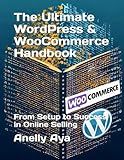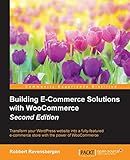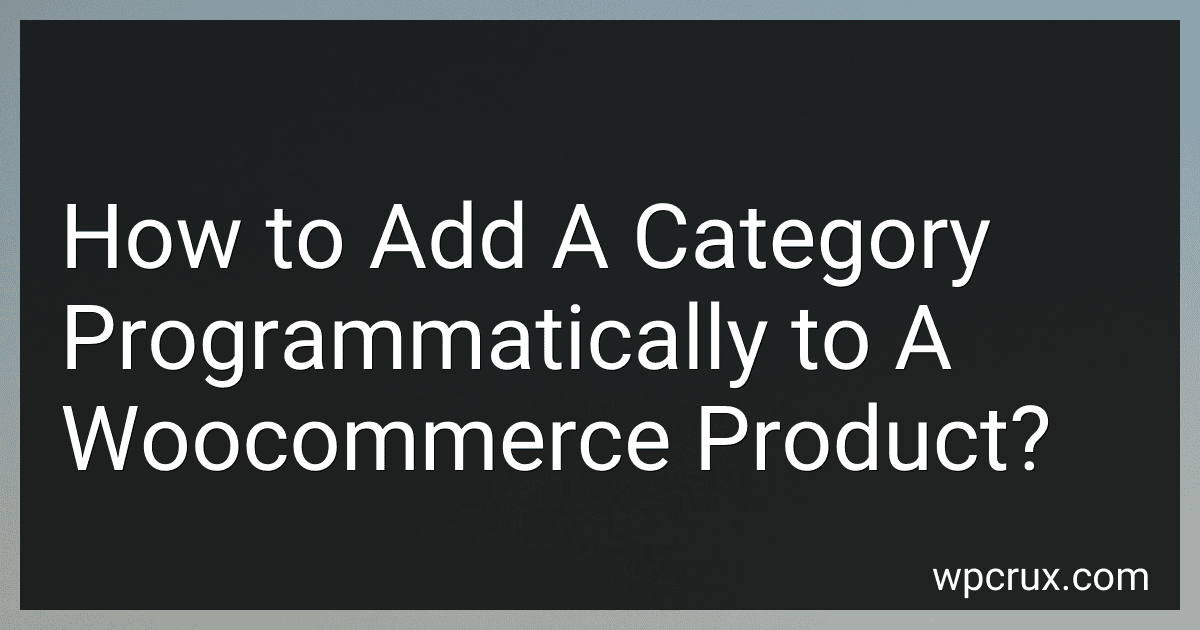Best Woocommerce Tools to Buy in October 2025

The Ultimate WordPress & WooCommerce Handbook: From Setup to Success in Online Selling



WordPress WooCommerce: Tienda online con WooCommerce (Spanish Edition)



Building E-Commerce Solutions with WooCommerce - Second Edition



WordPress WooCommerce: Webshop met WooCommerce (Dutch Edition)



Formation Woocommerce: Créer et exploiter une boutique en ligne (French Edition)



Setting Up and Running an Online Store


To add a category programmatically to a WooCommerce product, you can use the wp_set_object_terms() function. This function takes three parameters - the product ID, the category ID, and the taxonomy (which in this case is 'product_cat').
You can use the following code snippet to add a category to a product:
$product_id = 123; // Replace 123 with the ID of the product you want to add a category to $category_id = 1; // Replace 1 with the ID of the category you want to add $taxonomy = 'product_cat';
wp_set_object_terms( $product_id, $category_id, $taxonomy );
Make sure to replace the values of $product_id and $category_id with the appropriate IDs for your specific product and category. This code can be added to your theme's functions.php file or in a custom plugin to programmatically add a category to a WooCommerce product.
What tools and resources can help in creating a seamless process for adding categories to products in WooCommerce programmatically?
There are several tools and resources that can help in creating a seamless process for adding categories to products in WooCommerce programmatically:
- WooCommerce REST API: The WooCommerce REST API provides a way to interact with the WooCommerce platform programmatically, allowing you to create and update products, including assigning categories.
- WooCommerce Hooks: WooCommerce provides a number of hooks and filters that you can use to modify the behavior of the platform programmatically. You can use these hooks to automatically assign categories to products based on certain conditions.
- PHP programming language: You can use PHP to write custom scripts that interact with the WooCommerce platform and add categories to products. PHP is the language that WooCommerce is built on, so it is well-suited for creating custom functionality.
- WooCommerce API libraries: There are a number of libraries available that provide a more user-friendly way to interact with the WooCommerce REST API, such as the WooCommerce API PHP library. These libraries can help streamline the process of adding categories to products programmatically.
- WooCommerce documentation: The WooCommerce documentation provides a wealth of information on how to work with the platform programmatically. This includes detailed guides on how to create and update products, including assigning categories.
By using a combination of these tools and resources, you can create a seamless process for adding categories to products in WooCommerce programmatically.
How to code the feature of adding a category to a product in WooCommerce?
To add a category to a product in WooCommerce, you can use the wp_set_object_terms function provided by WordPress. Here is the step-by-step guide to code this feature:
- First, you need to get the product ID and the category ID you want to add to the product. You can get the product ID by using the get_the_ID() function if you are on a single product page, or $_POST['post_id'] if you are submitting a form.
- Next, you need to get the category ID you want to add to the product. You can do this by using the get_term_by function, passing the category name and the taxonomy (which is usually 'product_cat').
$product_id = get_the_ID(); // Get the product ID $category = 'Category Name'; // Set the category name
$category_id = get_term_by('name', $category, 'product_cat')->term_id; // Get the category ID
- Finally, you can add the category to the product using the wp_set_object_terms function.
wp_set_object_terms($product_id, $category_id, 'product_cat', true); // Add the category to the product
You can place this code in your theme's functions.php file or in a custom plugin to add this feature to your WooCommerce store. Make sure to customize the code based on your specific requirements and the structure of your WooCommerce site.
How to efficiently manage categories for products in WooCommerce through code?
To efficiently manage categories for products in WooCommerce through code, you can use the following methods:
- Use the WooCommerce API: You can use the WooCommerce REST API to programmatically create, update, and delete product categories. This allows you to automate category management tasks and streamline the process.
- Use the WordPress functions: You can use WordPress functions such as wp_insert_term, wp_update_term, and wp_delete_term to manage product categories in WooCommerce. These functions allow you to add, update, and delete categories directly from your code.
- Use hooks and filters: You can use hooks and filters provided by WooCommerce to manipulate category data and perform custom actions on categories. For example, you can use the woocommerce_before_save_product_cat hook to add custom data to categories before they are saved.
- Create custom scripts: If you have specific requirements for managing product categories in WooCommerce, you can create custom scripts to automate the process. For example, you can create a script that imports categories from a CSV file or updates category data based on certain criteria.
Overall, using the WooCommerce API, WordPress functions, hooks and filters, and custom scripts can help you efficiently manage categories for products in WooCommerce through code.
What are the necessary steps to add a category to a product in WooCommerce programmatically?
- Define the new category: First, you need to define the new category that you want to add to the product. You can do this by creating an array containing the category name, slug, and any other relevant information.
- Check if the category already exists: Before adding the new category, you should check if it already exists in your WooCommerce store. You can do this by using the get_term_by() function to retrieve the category object based on the category name or slug.
- Add the new category: If the category does not already exist, you can add it programmatically using the wp_insert_term() function. This function takes the category name, slug, and any other relevant information as parameters and adds the category to your WooCommerce store.
- Assign the category to the product: Finally, you need to assign the newly created category to the product. You can do this by using the wp_set_object_terms() function, which takes the product ID, the category ID, and the taxonomy name as parameters and assigns the category to the product.
By following these steps, you can programmatically add a new category to a product in WooCommerce.
How to debug and troubleshoot issues when adding categories to products in WooCommerce programmatically?
- Check for errors in your code: Make sure there are no syntax errors in your code and double-check that you are using the correct functions and hooks for adding categories to products in WooCommerce.
- Verify if the categories exist: Before adding new categories to products, verify that the categories you are trying to add actually exist in WooCommerce. If the categories do not exist, you will need to create them first before assigning them to products.
- Check for conflicting plugins or themes: Sometimes conflicts with other plugins or themes can cause issues when adding categories to products in WooCommerce. Disable all other plugins and switch to a default WordPress theme to see if the issue persists.
- Enable debugging mode: Enable debugging mode in WordPress to get more detailed error messages and pinpoint the source of the issue. You can do this by adding the following code to your wp-config.php file:
define( 'WP_DEBUG', true ); define( 'WP_DEBUG_LOG', true ); define( 'WP_DEBUG_DISPLAY', false );
- Utilize WooCommerce hooks and filters: Use WooCommerce hooks and filters to debug and troubleshoot issues with adding categories to products programmatically. You can add your own custom hooks to trace the flow of data and make sure that your code is executing as expected.
- Consult WooCommerce documentation: Refer to the official WooCommerce documentation and developer guides for more information on adding categories to products programmatically. There may be specific guidelines or best practices that can help you troubleshoot any issues you may encounter.
- Ask for help: If you are still unable to resolve the issue, consider seeking help from the WooCommerce community or hiring a developer with experience in WooCommerce development. They may be able to provide additional insights and assistance in troubleshooting the problem.
